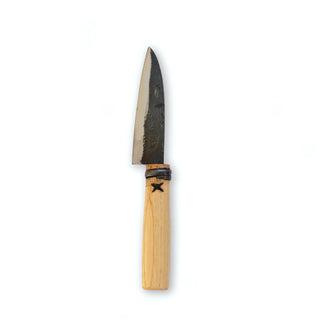Large Pairing Knife #59
- Unit price
- /per
This flat blade paring knife is just the right size for zesting citrus, peeling a pear, de-veining shrimp or other tight tasks a recipe requests of you — but larger than it's brother and can also be used to chop ginger, garlic or other small produce.
Materials:
Handle: chestnut or oak wood, shade-dried for years to achieve the correct weight, stability and water resistance
Blade: made from the strong steel used for railroad tracks
Dimensions: Handle 4.5" L / Blade 4.5" L x 1.3" W
Care: This knife is made of carbon steel and when properly cared for, can last for decades. There is no need to sharpen your knife but every two to three years, depending on frequency of use. Sharpen by hand on a whetstone.
- Do not use knife on hard surfaces such as stone or composite countertops or on glass cutting boards.
- To clean, do not put in the dishwasher or soak for a prolonged period. Wash by hand using water only or water with light soap.
- To prevent rust, be sure to dry the knife completely with a towel or above a low flame before storing in a dry place. Lightly oil the blade periodically.
- If rust forms on the blade, mix a paste of baking soda with a small amount of water and massage onto the blade using a soft cloth or toothbrush for more stubborn spots. Do not use foil or steel wool, which can cause deep scratches. Wipe the blade clean and wash with dish soap and dry well.
—
Anseong is a South Korean city known for its brass, stone, and iron implements, as well as a famous market of traditional craft and trade. The Shin Blacksmith was established there in 1845, today in the 5th generation of the family and the oldest blacksmith in Korea. At the age of 13, Master Shin In-Young began his apprenticeship and at 17 became a master, an unprecedented achievement even today. He produces there the best handmade knives and farming tools in the country. In 2016, Master Shin In-Young was named by the Gyeonggi Province as an Intangible Cultural Heritage Treasure #60, recognizing his rare, traditional skills and talent and remains the first individual to be awarded this great honor. He is the only artisan who practices a traditional technique of attaching steel sheets to clay. He teaches widely, in interest to pass down craft and tradition. When Korea undertook to restore the stone pagoda of the Mireuksa Temple in Iksan, Master Shin was prevailed upon to produce the necessary stone-working tools. Following old-world techniques and traditional minimalistic design, Master Shin creates high-quality, functional pieces that are also durable works of art.
Adding product to your cart






